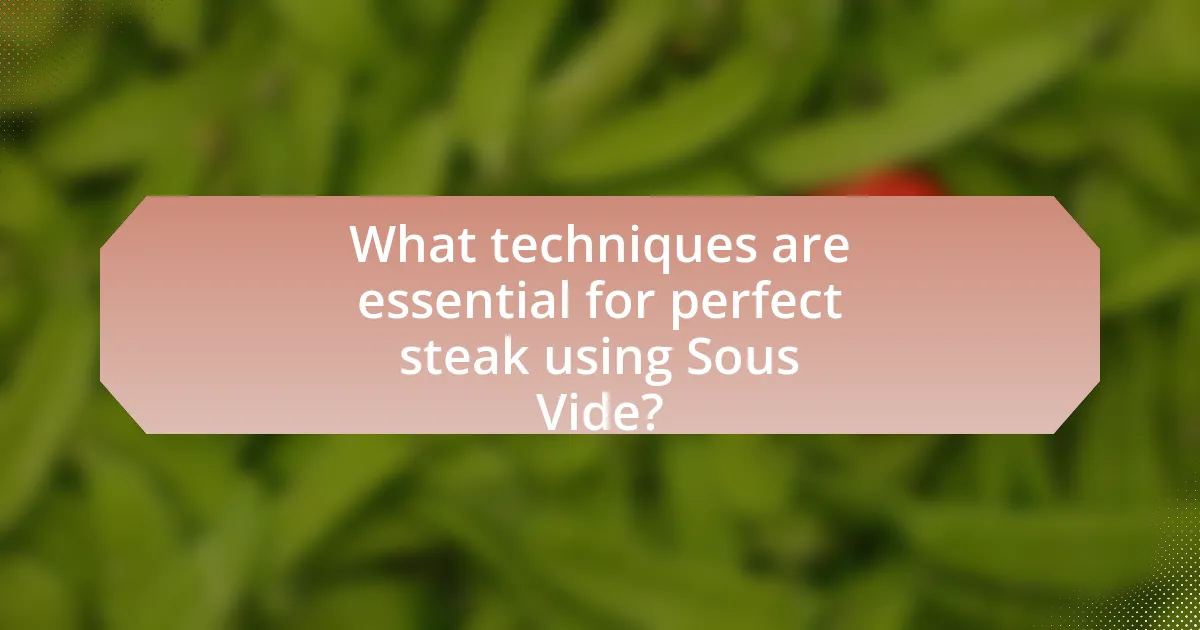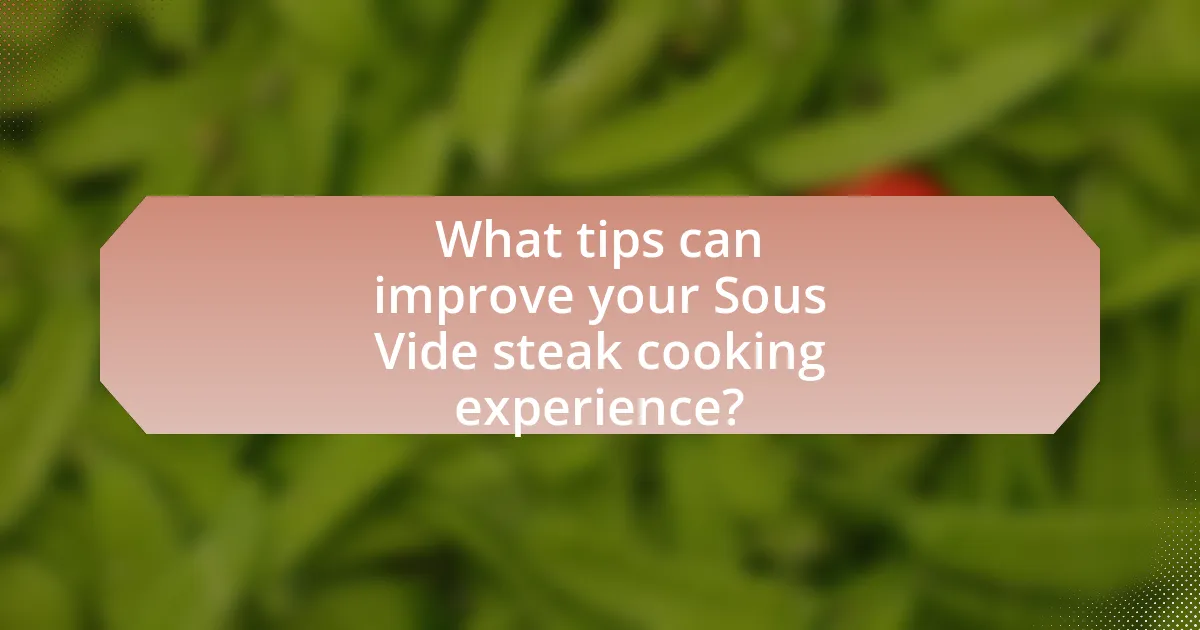Sous vide cooking is a precise method that involves cooking food in a vacuum-sealed bag submerged in a temperature-controlled water bath, allowing for even cooking and enhanced flavor retention. This article explores the essential components of sous vide cooking, including temperature control, recommended cooking times for various steak cuts, and techniques for achieving optimal flavor and tenderness. It also highlights the advantages of sous vide for steak preparation, such as consistent doneness and improved texture, while providing tips for selecting the right cut of meat and avoiding common mistakes. Additionally, best practices for ensuring food safety and achieving a perfect sear after cooking are discussed, making this a comprehensive guide for home cooks looking to master sous vide steak.

What is Sous Vide Cooking?
Sous vide cooking is a method of cooking food in a vacuum-sealed bag submerged in a water bath at a precisely controlled temperature. This technique allows for even cooking and enhanced flavor retention, as the food is cooked slowly and evenly, preventing overcooking. The sous vide method has been used in professional kitchens since the 1970s and has gained popularity among home cooks for its ability to produce consistent and high-quality results.
How does Sous Vide Cooking work?
Sous vide cooking works by immersing food in a water bath at a precisely controlled temperature for an extended period. This method allows for even cooking and retention of moisture, resulting in tender and flavorful dishes. The technique originated in the 1970s and has gained popularity due to its ability to produce consistent results, as the water temperature remains stable and prevents overcooking. Studies have shown that sous vide cooking can enhance the texture and taste of meats, making it particularly effective for preparing steak.
What are the essential components of Sous Vide Cooking?
The essential components of Sous Vide cooking are a precision immersion circulator, vacuum-sealed bags, and a temperature-controlled water bath. The immersion circulator heats and circulates water to maintain a consistent temperature, ensuring even cooking. Vacuum-sealed bags prevent water from entering the food while allowing for optimal heat transfer, which is crucial for achieving the desired doneness. The temperature-controlled water bath provides a stable environment for cooking, allowing food to be cooked to the exact level of doneness without the risk of overcooking. These components work together to create a precise cooking method that enhances flavor and texture in dishes, particularly in steak preparation.
How does temperature control impact the cooking process?
Temperature control is crucial in the cooking process as it directly affects the texture, flavor, and safety of food. In sous vide cooking, maintaining a precise temperature allows for even cooking throughout the steak, ensuring that it reaches the desired doneness without overcooking. Research indicates that cooking steak at a consistent temperature, such as 130°F for medium-rare, results in a tender and juicy product, as the proteins break down optimally without losing moisture. This method also minimizes the risk of foodborne illnesses by ensuring that the steak is held at safe temperatures for sufficient time to kill harmful bacteria.
What are the advantages of Sous Vide Cooking for steak?
Sous vide cooking offers precise temperature control, ensuring steak is cooked evenly throughout without the risk of overcooking. This method allows for consistent doneness, as the steak is submerged in a water bath at a specific temperature for an extended period, typically ranging from one to several hours. Research indicates that sous vide can enhance tenderness and juiciness, as the low-temperature cooking process breaks down collagen in tougher cuts while retaining moisture. Additionally, sous vide cooking allows for enhanced flavor infusion, as seasonings and marinades penetrate the meat more effectively during the cooking process.
How does Sous Vide Cooking enhance flavor and tenderness?
Sous vide cooking enhances flavor and tenderness by cooking food at precise, low temperatures in a vacuum-sealed bag, allowing for even heat distribution and moisture retention. This method prevents overcooking and ensures that proteins, such as steak, remain juicy and tender, as the low temperatures break down collagen without drying out the meat. Research indicates that sous vide cooking can improve the tenderness of beef by up to 30% compared to traditional cooking methods, as it allows for longer cooking times without the risk of drying out. Additionally, the vacuum-sealed environment intensifies flavors by concentrating juices and seasonings, resulting in a more flavorful final product.
What makes Sous Vide Cooking different from traditional methods?
Sous vide cooking differs from traditional methods by utilizing precise temperature control in a water bath to cook food evenly and retain moisture. Traditional cooking methods often rely on direct heat, which can lead to uneven cooking and moisture loss. Sous vide allows for cooking at lower temperatures for extended periods, resulting in tender and flavorful dishes, as demonstrated by a study published in the Journal of Culinary Science & Technology, which found that sous vide cooking can enhance the juiciness and texture of meats compared to conventional techniques.

What techniques are essential for perfect steak using Sous Vide?
The essential techniques for perfect steak using Sous Vide include precise temperature control, proper seasoning, vacuum sealing, and adequate finishing. Precise temperature control allows for consistent doneness throughout the steak, typically ranging from 130°F to 140°F for medium-rare. Proper seasoning enhances flavor; using salt and pepper before sealing is recommended. Vacuum sealing ensures that the steak cooks evenly and retains moisture. Finally, adequate finishing, such as searing the steak in a hot pan or on a grill after sous vide cooking, creates a desirable crust and enhances texture. These techniques collectively ensure a perfectly cooked steak with optimal flavor and tenderness.
How do you choose the right cut of steak for Sous Vide?
To choose the right cut of steak for Sous Vide, select cuts that benefit from low and slow cooking, such as ribeye, sirloin, or filet mignon. These cuts have the right balance of fat and tenderness, which enhances flavor and texture when cooked sous vide. Ribeye, for example, contains intramuscular fat that renders beautifully, resulting in a juicy steak. Sirloin offers a leaner option while still providing good flavor, and filet mignon is known for its tenderness. The sous vide method allows for precise temperature control, making it ideal for these cuts, which can be cooked to the desired doneness without the risk of overcooking.
What are the best cuts of steak for Sous Vide cooking?
The best cuts of steak for Sous Vide cooking include ribeye, filet mignon, sirloin, and flank steak. Ribeye is favored for its marbling, which enhances flavor and tenderness during the slow cooking process. Filet mignon is known for its buttery texture, making it ideal for precise temperature control in Sous Vide. Sirloin offers a balance of flavor and cost-effectiveness, while flank steak, when cooked Sous Vide, becomes tender and flavorful despite its lean nature. These cuts benefit from the Sous Vide method, which allows for even cooking and retention of moisture, resulting in a superior dining experience.
How does the thickness of the steak affect cooking time?
The thickness of the steak directly affects cooking time, with thicker steaks requiring longer cooking durations to reach the desired internal temperature. For example, a steak that is one inch thick typically takes about 1 to 1.5 hours to cook sous vide at 130°F for medium-rare, while a two-inch thick steak may take 2 to 3 hours to achieve the same doneness. This relationship is due to the need for heat to penetrate the meat evenly; thicker cuts take more time for the heat to reach the center.
What is the ideal temperature and cooking time for steak?
The ideal temperature for cooking steak using sous vide is typically between 129°F to 134°F (54°C to 57°C) for medium-rare, with a cooking time of 1 to 4 hours. This method ensures precise temperature control, allowing the steak to cook evenly throughout while retaining moisture and tenderness. Research indicates that cooking steak at these temperatures for the specified duration results in optimal texture and flavor, as sous vide cooking allows for consistent results without the risk of overcooking.
How do different temperatures affect the doneness of steak?
Different temperatures significantly affect the doneness of steak by determining its internal texture and juiciness. For example, cooking steak at 120°F results in rare doneness, characterized by a cool, red center, while 130°F yields medium-rare, which has a warm, red center. At 140°F, steak reaches medium doneness, displaying a pink center, and at 160°F, it becomes medium-well, with a slightly pink center. Finally, cooking steak at 170°F or higher results in well-done, which is uniformly brown throughout. These temperature ranges are critical for achieving the desired doneness, as they influence the meat’s moisture retention and tenderness.
What are the recommended cooking times for various steak cuts?
The recommended cooking times for various steak cuts using sous vide techniques are as follows: for filet mignon, cook for 1 to 4 hours at 130°F (54°C) for medium-rare; for ribeye, cook for 1 to 4 hours at 131°F (55°C) for medium-rare; for sirloin, cook for 1 to 4 hours at 130°F (54°C) for medium-rare; and for flank steak, cook for 2 to 4 hours at 130°F (54°C) for medium-rare. These times ensure that the steak reaches the desired doneness while maintaining tenderness and flavor. Sous vide cooking allows for precise temperature control, resulting in consistent and high-quality steak.

What tips can improve your Sous Vide steak cooking experience?
To improve your Sous Vide steak cooking experience, ensure precise temperature control by using a reliable immersion circulator set to the desired doneness level, typically between 129°F to 135°F for medium-rare. This temperature range allows for optimal tenderness and juiciness, as sous vide cooking effectively breaks down collagen in the meat without overcooking. Additionally, seasoning the steak with salt and pepper before vacuum sealing enhances flavor penetration during the cooking process. Research indicates that sous vide cooking can retain more moisture compared to traditional methods, resulting in a more succulent steak. Finally, searing the steak in a hot pan or on a grill for a short time after sous vide cooking creates a desirable crust, enhancing both texture and flavor.
How can you enhance the flavor of your Sous Vide steak?
To enhance the flavor of your Sous Vide steak, incorporate herbs, spices, and aromatics during the cooking process. Adding ingredients such as garlic, rosemary, thyme, or even a splash of soy sauce in the vacuum-sealed bag infuses the meat with rich flavors as it cooks at a precise temperature. Research indicates that marinating steak before Sous Vide cooking can also improve flavor penetration, as the low-temperature cooking allows for better absorption of these flavor compounds.
What seasonings and marinades work best for Sous Vide steak?
The best seasonings and marinades for Sous Vide steak include salt, pepper, garlic, rosemary, thyme, and soy sauce. Salt enhances the natural flavor of the steak, while pepper adds a mild heat. Garlic, rosemary, and thyme provide aromatic qualities that complement the meat. Soy sauce introduces umami and depth.
Using these seasonings in combination can elevate the taste profile of the steak. For example, a simple marinade of soy sauce, garlic, and rosemary can infuse the steak with rich flavors during the Sous Vide process, which typically involves cooking at lower temperatures for extended periods, allowing the meat to absorb the seasonings effectively.
How can you achieve a perfect sear after Sous Vide cooking?
To achieve a perfect sear after Sous Vide cooking, first, ensure the meat is thoroughly dried using paper towels to remove moisture, as excess water inhibits browning. Next, preheat a heavy skillet or cast-iron pan over high heat until it is smoking hot, which allows for rapid Maillard reaction, creating a flavorful crust. Then, add a small amount of high smoke point oil, such as canola or avocado oil, to the pan. Sear the meat for 1-2 minutes on each side, or until a golden-brown crust forms. This method is effective because the high temperature of the pan combined with the dry surface of the meat promotes optimal searing, resulting in a desirable texture and flavor.
What common mistakes should you avoid when cooking steak Sous Vide?
Common mistakes to avoid when cooking steak Sous Vide include not seasoning the steak adequately, cooking at incorrect temperatures, and failing to properly seal the bag. Inadequate seasoning can lead to bland flavors, as the sous vide process intensifies the meat’s natural taste without adding external flavors. Cooking at incorrect temperatures can result in overcooked or undercooked steak; for example, cooking a ribeye at 130°F for 1-4 hours achieves a medium-rare doneness, while temperatures above this can lead to undesirable textures. Lastly, failing to properly seal the bag can cause water to enter, diluting flavors and affecting the cooking process. Proper vacuum sealing ensures that the steak cooks evenly and retains its juices.
How can improper sealing affect the cooking process?
Improper sealing can lead to uneven cooking and loss of flavor during the sous vide process. When a vacuum seal is not airtight, water can enter the bag, diluting the seasoning and affecting the meat’s texture. Additionally, inadequate sealing can result in temperature fluctuations, preventing the steak from reaching the desired doneness. Research indicates that maintaining a consistent temperature is crucial for achieving optimal results in sous vide cooking, as variations can compromise the cooking process and the final quality of the steak.
What are the pitfalls of not preheating the water bath?
Not preheating the water bath can lead to uneven cooking and longer cooking times. When the water bath is not at the desired temperature, the food may spend too much time in the temperature danger zone, which can affect texture and safety. For instance, proteins may not reach the optimal doneness, resulting in a less desirable final product. Additionally, starting with a cold water bath can cause the food to cook inconsistently, as the outer layers may overcook while the center remains undercooked. This inconsistency undermines the precision that sous vide cooking aims to achieve.
What are the best practices for Sous Vide steak cooking?
The best practices for sous vide steak cooking include selecting the right cut of meat, seasoning adequately, setting the correct temperature and time, and finishing with a proper sear. Choosing cuts like ribeye or filet mignon enhances tenderness and flavor, while seasoning with salt and pepper before sealing in a vacuum bag ensures flavor penetration. Cooking steak at a temperature between 129°F to 135°F for medium-rare, for 1 to 4 hours, allows for optimal texture and doneness. Finally, searing the steak in a hot pan or on a grill for 1-2 minutes per side after sous vide cooking creates a desirable crust. These practices are supported by sous vide cooking principles, which emphasize precise temperature control and even cooking throughout the meat.
How can you ensure food safety when using Sous Vide techniques?
To ensure food safety when using Sous Vide techniques, maintain precise temperature control and adhere to recommended cooking times. Cooking food at a temperature of at least 130°F (54°C) for a minimum of one hour effectively kills harmful bacteria, as supported by research from the USDA, which states that holding food at this temperature for the specified duration ensures safety. Additionally, using vacuum-sealed bags prevents contamination and allows for even cooking, further enhancing food safety.
What tools and equipment are essential for successful Sous Vide cooking?
Essential tools and equipment for successful Sous Vide cooking include a precision immersion circulator, vacuum sealer, and heat-safe bags. The precision immersion circulator maintains a consistent water temperature, crucial for achieving the desired doneness in steak, while the vacuum sealer removes air from bags to ensure even cooking and prevent water from entering. Heat-safe bags, often made of BPA-free plastic, are designed to withstand prolonged exposure to hot water without leaching harmful chemicals. These components work together to create the ideal environment for Sous Vide cooking, ensuring perfectly cooked steak every time.


